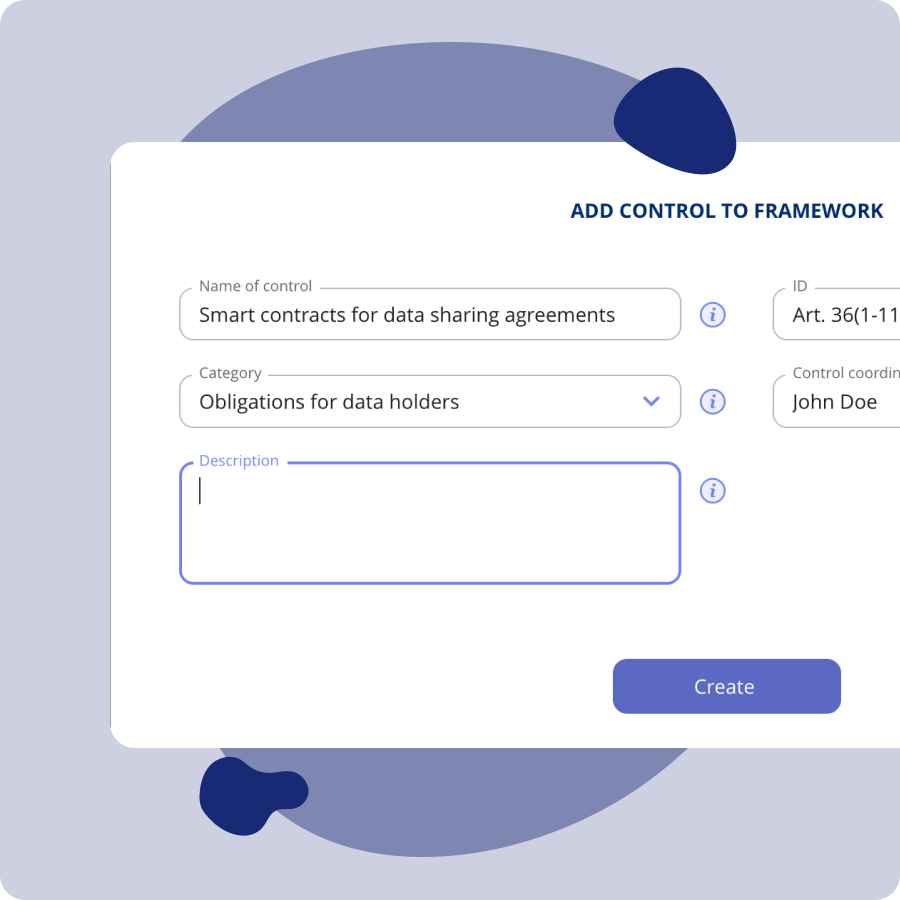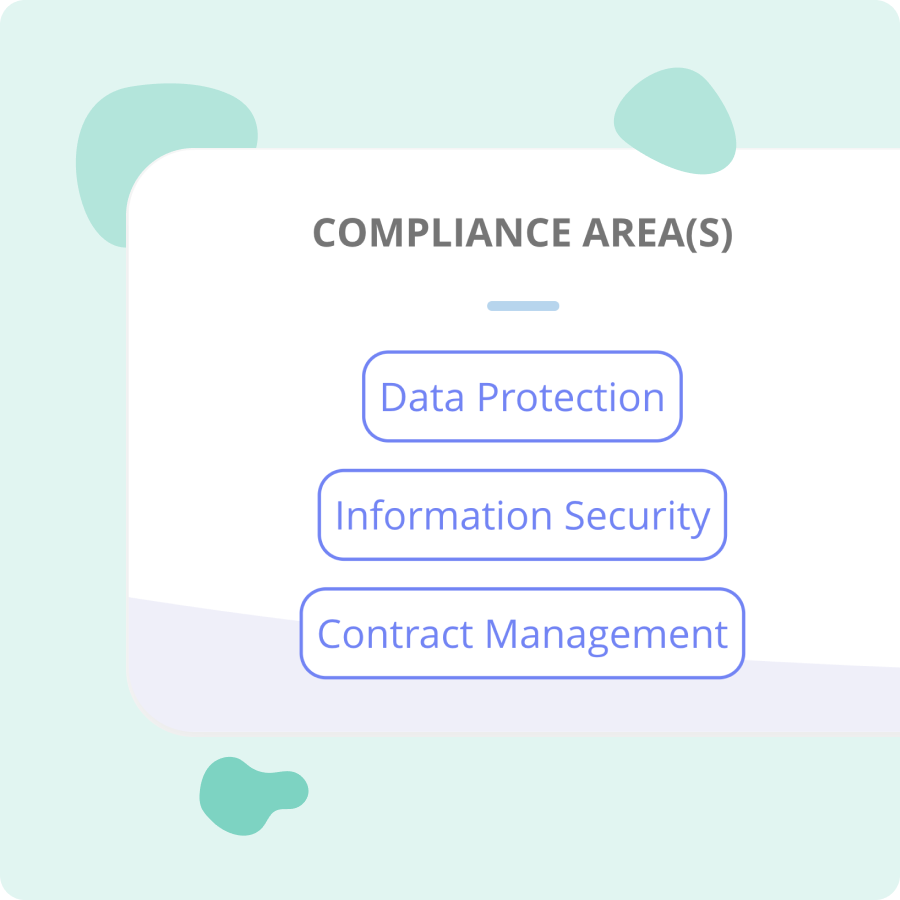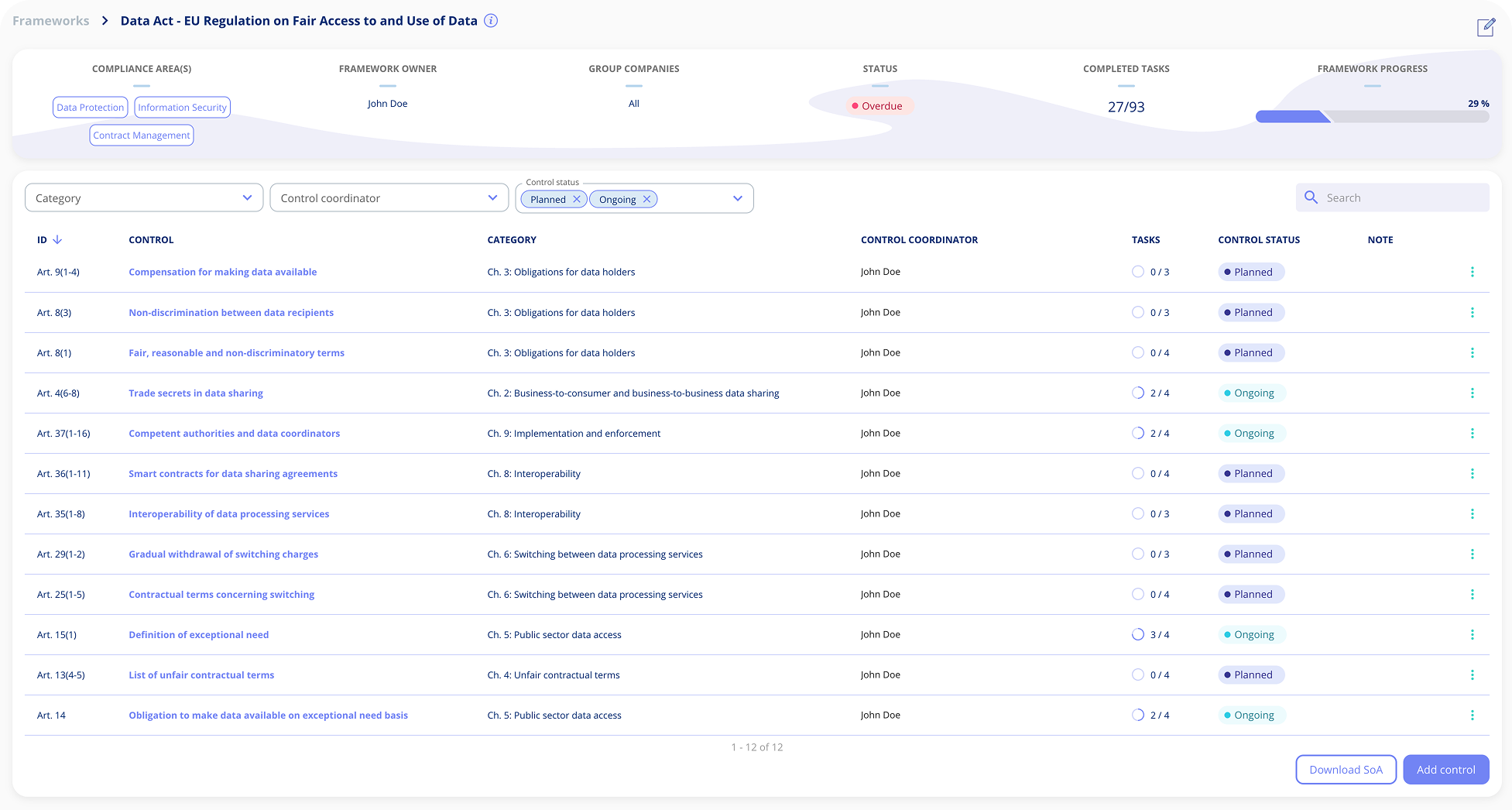
DATA ACT FRAMEWORK Navigate confidently through Data Act Compliance
The EU Data Act will come into force on 12 September 2025. It entails complex rules, multiple roles and overlapping requirements. We have mapped it all out in a clear, action-oriented framework for optimal Data Act compliance.
-
Complete Data Act framework with 25 articles mapped to specific tasks
-
Select only the requirements that apply to your organisation – save time and resources
-
Real-time compliance tracking shows exactly where you stand with the Data Act
-
Reuses existing GDPR and NIS2 tasks - don't do thing twice

DATA ACT FRAMEWORK Who needs the Data Act Framework?
Not sure if the Data Act applies to your organisation? The Data Act Framework helps you identify your obligations quickly and accurately.
You are covered by the Data Act if you:
-
Manufacture products with internet connectivity (IoT products) that collect data
-
Offer services working with connected products and sell in the EU
-
Control or have access to data from connected products
-
Receive data from other companies or users in the EU
-
Are a public institution requesting data from private companies
-
Provide cloud services (IaaS, SaaS, PaaS)
In short
If your company produces, handles, or provides services using data from smart products, or offers cloud solutions, the Data Act applies to you.

DATA ACT FRAMEWORK Tailor your Data Act compliance approach
How to design your framework:
-
Identify your role - manufacturer, data holder, or cloud provider
-
Find applicable chapters that affect your business operations
-
Focus on relevant articles to prioritise your compliance efforts
-
Assess risk and impact for strategic implementation
Framework Modules by Role:
-
IoT Products
Do you manufacture smart products or offer related services? Chapter II applies, covering data accessibility requirements and user rights
-
Cloud Services
Cloud service providers must comply with Chapter VI on cloud switching - making it easier for customers to change providers and avoid vendor lock-in.
-
Public authority
Public authorities gain special data request rights under Chapter V but must follow strict procedural requirements and safeguards.
-
SME Advantages
Small businesses receive enhanced protection against unfair contract terms and special benefits under compensation rules.

DATA ACT FRAMEWORK Leverage synergies with existing compliance frameworks
The Data Act Framework integrates seamlessly with your existing compliance programmes. Don't repeat work - maximise the value of your current investments:
Framework Synergies:
-
The same security controls can meet multiple requirements at the same time
-
Documentation and processes can be reused across frameworks
-
Investing in one area strengthens compliance on several fronts
-
Less duplication of work and resources
Examples of overlapping frameworks
-
GDPR
Personal data handling, consent and data subjects' rights. The Data Act complements the GDPR with extended portability rights for IoT data.
-
NIS2 Security
Cybersecurity requirements for critical infrastructure overlap with the Data Act's requirements for protection against illegal data access from third countries.
-
ISO 27001
Information security management and risk management directly support the Data Act's requirements for technical and organisational security measures.
-
AI Act Transparence
Requirements for openness and explainability in AI systems have similarities with the Data Act's transparency obligations towards users of IoT products.
Our Customers
-
+360
companies
-
+10.000
users
-
+79.000
contracts
-
+14.000
processing activities
-
Lægeforeningen Michael Berner (Lawyer).legal has been the right choice for us. .legal are professional and welcoming with skilled employees.
-
Min By Media Tinna Schultz (HR manager)It just works! It is so easy and user-friendly, and the overview of processing activities is brilliant.
-
Bech-Bruun Mikkel Friis Rossa (Partner).legal's team has consistently demonstrated a commitment to innovation while being responsive to the needs of our mutual clients.
-
DMJX Kaspar Rochholz (GDPR coordinator).legal has really understood what it means to create a user-friendly and efficient solution. Privacy is an attractive product compared to price and functionality.
-
Axel Kaufmann ApS Julie Lundkvist Andreasen (Lawyer and Head of Customer Service).legal continuously update the platform to ensure their customers always remain compliant. In our view, any other choice would be a downgrade.
-
Molecule Consultancy Nanna Rodian Christensen (HR & Operational Manager)Firstly, it means that not all the work is in one place (me), and secondly, that the understanding of GDPR is implemented throughout the organisation.
Framework prices Data Act Framework Prices
Frameworks
From €135
pr. month
-
Unlimited number of users
-
Unlimited number of frameworks
-
Combine with data protection and information security
Monthly payments in advance, annual commitment.
.legal Compliance Hub
Read all about .legals compliance on our compliance hub.
-
ISAE 3402
ISAE 3402 statementGet a copy of .legal A/S's latest ISAE3402 (type 2) IT security statement
-
ISAE 3000
ISAE 3000 statementGet a copy of .legal A/S's latest ISAE3000 (type 2) statement of our GDPR compliance
-
Data Processing Agreement (DPA)
Data processing agreementFind .legal A/S's data processing agreement here.
-
IT security
IT Security MeasuresAll .legal A/S's implemented and approved IT security measures are described here.
Frequently Asked Questions about Data Act
What is the EU Data Act Framework?
The EU Data Act Framework is a comprehensive compliance solution that maps all 25 operational articles of the Data Act (Regulation EU 2023/2584) into actionable tasks. It helps organisations understand their obligations, track compliance progress, and integrate with existing frameworks like GDPR and NIS2.
When does the Data Act come into force?
The EU Data Act comes into force on 12 September 2025. Organisations covered by the regulation must be compliant by this date, making it crucial to start preparation now.
Does the Data Act apply to companies outside the EU?
Yes, if you place connected products on the EU market or offer related services to EU users. The Data Act has extraterritorial reach similar to GDPR, requiring non-EU companies to comply when serving EU markets.
How does the Data Act interact with GDPR?
The Data Act complements and enhances GDPR, particularly around data portability rights for IoT devices. GDPR rules take precedence for personal data processing, while the Data Act covers broader data sharing obligations including non-personal data.
Learn more: GDPR and Data Act Interaction
What are connected products under the Data Act?
Connected products are items that can generate, obtain, or collect data about their use, performance, or environment, and can communicate this data. This includes smart home appliances, industrial machinery, medical devices, vehicles, and consumer electronics.
Can I use existing compliance documentation for the Data Act?
Yes, the Data Act Framework is designed to leverage existing GDPR, NIS2, and ISO 27001 documentation. Many security controls and risk management processes can satisfy multiple regulatory requirements simultaneously.
Learn more: Information Security Management
What happens if my organisation doesn't comply with the Data Act?
Member States will establish penalties for non-compliance. Additionally, data protection authorities can impose GDPR fines for violations involving personal data under the Data Act. Early preparation is essential to avoid penalties and ensure smooth operations.
How can .legal help with Data Act compliance?
.legal's Data Act Framework provides role-specific compliance tracking, integrates with existing frameworks, offers expert-designed templates, and includes real-time progress monitoring. Our platform simplifies complex regulatory requirements into manageable tasks.
Start your compliance journey: Book a Demo
Is the Data Act Framework suitable for small businesses?
Yes, the Data Act includes special protections for SMEs, and our framework is designed to scale for organisations of all sizes. Small businesses benefit from enhanced protection against unfair contract terms and streamlined compliance processes.
Can I integrate the Data Act Framework with other compliance modules?
Absolutely. The Data Act Framework integrates seamlessly with our GDPR, NIS2, ISO 27001, and other compliance modules, allowing you to manage all regulatory requirements from a single platform.
See all modules: Compliance Frameworks



.jpeg)

.jpg)
.jpg)



.jpg)

-1.png)



.jpeg)








.jpg)





Info
.legal A/S
hello@dotlegal.com
+45 7027 0127
VAT-no: DK40888888
Support
support@dotlegal.com
+45 7027 0127
Need help?
Let me help you get started

+45 7027 0127 and I'll get you started
.legal is not a law firm and is therefore not under the supervision of the Bar Council.











